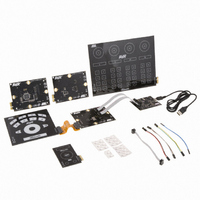ATQT600 Atmel, ATQT600 Datasheet - Page 47

ATQT600
Manufacturer Part Number
ATQT600
Description
KIT EVAL TOUCH FOR QT600
Manufacturer
Atmel
Series
QTouch™r
Specifications of ATQT600
Sensor Type
Touch Screen
Interface
USB
Embedded
Yes, Other
Utilized Ic / Part
ATtiny88, ATmega324PA, ATxmega128A1
Processor To Be Evaluated
ATtiny88, ATmega324, ATxmega128
Data Bus Width
8 bit, 16 bit
Interface Type
USB
Maximum Operating Temperature
+ 85 C
Minimum Operating Temperature
- 40 C
Operating Supply Voltage
1.6 V to 3.6 V
Silicon Manufacturer
Atmel
Kit Application Type
Sensor
Application Sub Type
Touch Sensor
Kit Contents
USB Bridge, MCU Cards, Touchpad Cards
Svhc
No SVHC (15-Dec-2010)
Mcu Supported Families
ATtiny88,
Rohs Compliant
Yes
Lead Free Status / RoHS Status
Lead free / RoHS Compliant
Voltage - Supply
-
Sensitivity
-
Sensing Range
-
Lead Free Status / Rohs Status
Lead free / RoHS Compliant
Available stocks
Company
Part Number
Manufacturer
Quantity
Price
Company:
Part Number:
ATQT600
Manufacturer:
Atmel
Quantity:
135
5.1
5.2
5.2.1
5.2.2
Touch Sensors Design Guide
Introduction
General Advice
Ground Loading
Interconnection
This section describes how you design one-dimensional sensors using a self-capacitance
implementation (see
implement sliders or wheels for use with QTouch sensor controllers. Note that three active channels are
used in all the cases described in this section.
This type of sensor is normally only used with planar type construction methods. For construction ideas
see
Method” on page
Two types of sensor can be considered:
This section discusses both types of sensors.
One of the most important things to keep in mind with sliders and wheels is that they work best when
they have well-balanced sensitivities across all channels. Avoid ground loading underneath sliders and
wheels, as uneven or excessive ground loading underneath the sensors will render them useless.
Moderate or even ground loading may work, but the resolution of the output is reduced.
Generally speaking, avoid running any foreign traces or components underneath slider or wheel
sensors.
The following guidlines should be followed when designing the traces for slider and wheel sensors:
Spatially interpolated
This type uses the shape of the electrodes to spatially interpolate the electric fields above the sensor.
Resistively interpolated
This type uses physical resistors to electrically interpolate the electrodes. This type of sensor allows
for a simpler electrode design. It also allows larger sensors to be constructed.
Always run all three channel connections together as a group and keep them well away from noisy
sources and ground loads.
Keep the traces as short and thin as possible and space the traces with a gap equal to the track width.
When routing traces from the electrodes, use a via, if possible, for each electrode to route the traces
down to the non-touch side of the board, and then run the traces away on this layer.
Section 3.3.1 “Printed Electrode Method” on page 3-8
3-10.
Self-capacitance One-dimensional Sensors
Section 1.2
and
Section
1.3). These styles of sensors are typically used to
and
Section 3.3.3 “Secondary Substrate
Section 5
10620D–AT42–04/09
5-1













